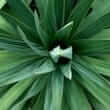Background
- Yucca is the common name for the more than 40 species of perennials in the Yucca genus. The plants are well known for their tough, sword-like leaves and a large spike of whitish flowers. They are native to the hot and dry parts of North America, Central America, and the West Indies, although they are popular landscaping plants and can be found worldwide.
- There is insufficient evidence in humans to support the use of yucca for any indication. One human study indicates that a blend of Yucca schidigera and Quillaja saponaria extracts may reduce cholesterol levels in hypercholesterolemic patients. Preliminary studies also indicate that yucca may have antioxidant, antifungal, and anti-inflammatory properties.
References
Natural Standard developed the above evidence-based information based on a thorough systematic review of the available scientific articles. For comprehensive information about alternative and complementary therapies on the professional level, go to . Selected references are listed below.
- Balestrieri C, Felice F, Piacente S, et al. Relative effects of phenolic constituents from Yucca schidigera Roezl. bark on Kaposi's sarcoma cell proliferation, migration, and PAF synthesis. Biochem Pharmacol 5-14-2006;71(10):1479-1487.
View Abstract - Favel A, Kemertelidze E, Benidze M, et al. Antifungal activity of steroidal glycosides from Yucca gloriosa L. Phytother Res 2005;19(2):158-161.
View Abstract - Hayashi K, Nishino H, Niwayama S, et al. Yucca leaf protein (YLP) stops the protein synthesis in HSV-infected cells and inhibits virus replication. Antiviral Res 1992;17(4):323-333.
View Abstract - Kanerva L, Estlander T, Petman L, et al. Occupational allergic contact urticaria to yucca (Yucca aloifolia), weeping fig (Ficus benjamina), and spathe flower (Spathiphyllum wallisii). Allergy 2001;56(10):1008-1011.
View Abstract - Kim SW, Park SK, Kang SI, et al. Hypocholesterolemic property of Yucca schidigera and Quillaja saponaria extracts in human body. Arch Pharm Res 2003;26(12):1042-1046.
View Abstract - Mahillon V, Saussez S, Michel O. High incidence of sensitization to ornamental plants in allergic rhinitis. Allergy 2006;61(9):1138-1140.
View Abstract - Munno G, Giannoccaro F, Riva G, et al. Allergy to yucca. Allergy 2001;56(9):921-922.
View Abstract - Olas B, Wachowicz B, Majsterek I, et al. Antioxidant properties of trans-3,3',5,5'-tetrahydroxy-4'-methoxystilbene against modification of variety of biomolecules in human blood cells treated with platinum compounds. Nutrition 2006;22(11-12):1202-1209.
View Abstract - Poljacki M, Paravina M, Jovanovic M, et al. [Contact allergic dermatitis caused by plants]. Med Pregl 1993;46(9-10):371-375.
View Abstract







